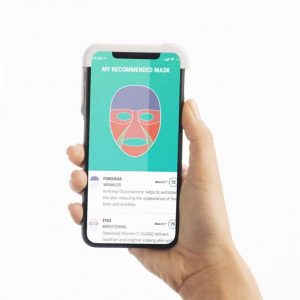Face masks have been especially popular lately, and I don’t mean the Halloween type – I mean the kind that contain all sorts of beauty- and health-enhancing ingredients. They look funny, but they can do great things for your skin. What’s one way to make an already-popular product even hotter? Personalize it! That’s what Neutrogena is doing with the new Neutrogena MaskiD, which will be unveiled next week at CES 2019. The 3D printed face mask is customized to fit each individual wearer’s exact face shape and size, and will be formulated with custom ingredients to address the wearer’s specific skin concerns.
 There’s been a recent craze for personalized hair care products, so it’s not much of a surprise that the skin care industry is getting in on the action as well. The tech behind it is pretty cool – the user simply uses their smartphone to take a selfie in the MaskiD app, then chooses which type of skin treatment product they want printed on each area of the mask. There are six zones: forehead, eye area, cheeks, nose, nasolabial folds, and the chin. Neutrogena offers a device called the Neutrogena Skin360, which attaches to smartphones and scans things like the size of pores and fine lines as well as skin moisture levels, then offers the user recommendations for each area.
There’s been a recent craze for personalized hair care products, so it’s not much of a surprise that the skin care industry is getting in on the action as well. The tech behind it is pretty cool – the user simply uses their smartphone to take a selfie in the MaskiD app, then chooses which type of skin treatment product they want printed on each area of the mask. There are six zones: forehead, eye area, cheeks, nose, nasolabial folds, and the chin. Neutrogena offers a device called the Neutrogena Skin360, which attaches to smartphones and scans things like the size of pores and fine lines as well as skin moisture levels, then offers the user recommendations for each area.
 If the user doesn’t have the Skin360, they can fill out a skin questionnaire online for personalized recommendations – or they can choose their own ingredients. Once they’ve submitted their requirements and selfie, the final mask will be illustrated with color-coding to show which ingredients will be placed where. Then a mask will be 3D printed that fits the user’s face to a T-zone.
If the user doesn’t have the Skin360, they can fill out a skin questionnaire online for personalized recommendations – or they can choose their own ingredients. Once they’ve submitted their requirements and selfie, the final mask will be illustrated with color-coding to show which ingredients will be placed where. Then a mask will be 3D printed that fits the user’s face to a T-zone.
“Using micro 3-D-printing, we can actually get your exact eye alignment, your nose, your mouth, how high [your] forehead is,” said Michael Southall, Research Director and Global Lead of Beauty Tech at Neutrogena. “The color coding is a way of illustrating what benefits they’re getting in each region, and every zone can be different. The key with 3-D printing is [that] we can put the active [ingredient] you want just where you need it, anywhere on the mask, as opposed to one product that you’re trying to use all over the face.”
There are only five ingredients that will be used on the masks, but they were carefully chosen by Neutrogena’s team of dermatologists, chemists and biologists:
- Hyaluronic acid, which helps hydrate skin and improve its moisture barrier
- Vitamin C, an antioxidant that helps lighten dark spots
- Niacinamide, an anti-inflammatory that can improve discoloration
- Feverfew, an herb that can reduce redness
- N-acetylglucosamine, which reduces fine lines
More ingredients could be added in the future, according to Southall.
“We’re really envisioning having a sort of library of skin-care ingredients that you could choose from that would allow you to get very specific treatments, [all] data-driven to help you understand your skin’s needs,” he said. “Every face is different — everything from the shape of the face to where the individual needs of a consumer are.”
The masks will officially be released to consumers in likely September of this year and are expected to be reasonably priced.
Discuss this and other 3D printing topics at 3DPrintBoard.com or share your thoughts below.
[Source: Allure]
Subscribe to Our Email Newsletter
Stay up-to-date on all the latest news from the 3D printing industry and receive information and offers from third party vendors.
You May Also Like
Gorilla Sports GE’s First 3D Printed Titanium Cast
How do you help a gorilla with a broken arm? Sounds like the start of a bad joke a zookeeper might tell, but it’s an actual dilemma recently faced by...
Nylon 3D Printed Parts Made More Functional with Coatings & Colors
Parts 3D printed from polyamide (PA, Nylon) 12 using powder bed fusion (PBF) are a mainstay in the additive manufacturing (AM) industry. While post-finishing processes have improved the porosity of...
$25M to Back Sintavia’s Largest Expansion of Metal 3D Printing Capacity Since 2019
Sintavia, the digital manufacturing company specializing in mission-critical parts for strategic sectors, announced a $25 million investment to increase its production capacity, the largest expansion to its operations since 2019....
Velo3D Initiates Public Offering in a Bid to Strengthen Financial Foundations and Drive Future Growth
Velo3D (NYSE: VLD) has been among a number of publicly traded 3D printing firms that have attempted to weather the current macroeconomic climate. After posting a challenging financial report for 2023,...
































